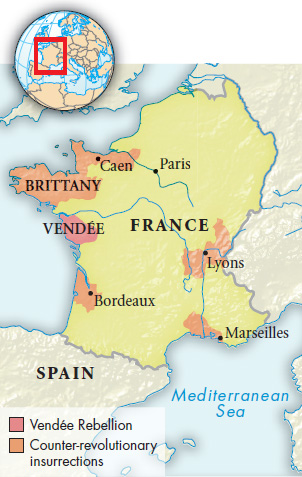The Second Revolution and the New Republic
The fall of the monarchy marked a radicalization of the Revolution, a phase that historians often call the second revolution. Louis’s imprisonment was followed by the September Massacres. Fearing invasion by the Prussians and riled up by rumors that counter-revolutionaries would aid the invaders, angry crowds stormed the prisons and killed jailed priests and aristocrats. In late September 1792 the new, popularly elected National Convention, which replaced the Legislative Assembly, proclaimed France a republic, a nation in which the people, instead of a monarch, held sovereign power.
As with the Legislative Assembly, many members of the new National Convention belonged to the Jacobin Club of Paris. But the Jacobins themselves were increasingly divided into two bitterly opposed groups — the Girondists (juh-RAHN-dihsts) and the Mountain, led by Robespierre and another young lawyer, Georges Jacques Danton.
This division emerged clearly after the National Convention overwhelmingly convicted Louis XVI of treason. The Girondists accepted his guilt but did not wish to put the king to death. By a narrow majority, the Mountain carried the day, and Louis was executed on January 21, 1793, by guillotine, which the French had recently perfected. Marie Antoinette suffered the same fate later that year. But both the Girondists and the Mountain were determined to continue the “war against tyranny.” The Prussians had been stopped at the Battle of Valmy on September 20, 1792, one day before the republic was proclaimed. French armies then invaded Savoy and captured Nice, moved into the German Rhineland, and by November 1792 were occupying the entire Austrian Netherlands (modern Belgium).
Everywhere they went, French armies of occupation chased princes, abolished feudalism, and found support among some peasants and middle-class people. But French armies also lived off the land, requisitioning food and supplies and plundering local treasures. The liberators therefore looked increasingly like foreign invaders. Meanwhile, international tensions mounted. In February 1793 the National Convention, at war with Austria and Prussia, declared war on Britain, the Dutch Republic, and Spain as well. Republican France was now at war with almost all of Europe.

Groups within France added to the turmoil. Peasants in western France revolted against being drafted into the army, with the Vendée region of Brittany emerging as the epicenter of revolt. Devout Catholics, royalists, and foreign agents encouraged their rebellion, and the counter-revolutionaries recruited veritable armies to fight for their cause.
In March 1793 the National Convention was locked in a life-and-death political struggle between members of the Mountain and the more moderate Girondists. With the middle-class delegates so bitterly divided, the people of Paris once again emerged as the decisive political factor. The laboring poor and the petty traders were often known as the sans-culottes because their men wore trousers instead of the knee breeches of the aristocracy and the solid middle class. (See “Primary Source 19.4: Contrasting Visions of the Sans-Culottes.”) They demanded radical political action to defend the Revolution. The Mountain, sensing an opportunity to outmaneuver the Girondists, joined with sans-culottes activists to engineer a popular uprising. On June 2, 1793, armed sans-culottes invaded the Convention and forced its deputies to arrest twenty-nine Girondist deputies for treason. All power passed to the Mountain.
The Convention also formed the Committee of Public Safety in April 1793 to deal with threats from within and outside France. The committee, led by Robespierre, held dictatorial power, allowing it to use whatever force necessary to defend the Revolution. Moderates in leading provincial cities revolted against the committee’s power and demanded a decentralized government. Counter-revolutionary forces in the Vendée won significant victories, and the republic’s armies were driven back on all fronts. By July 1793 only the areas around Paris and on the eastern frontier were firmly held by the central government. Defeat seemed imminent.